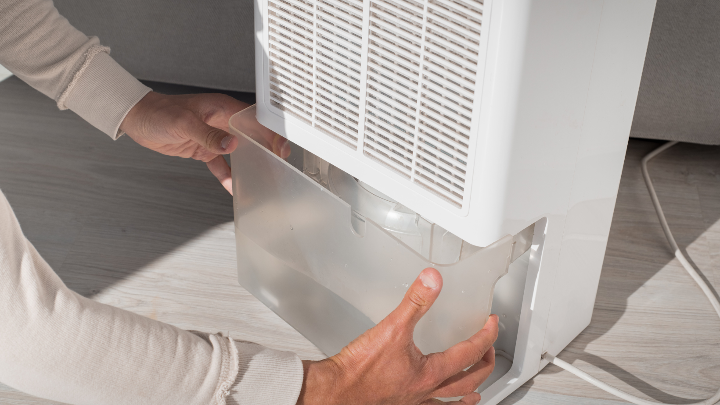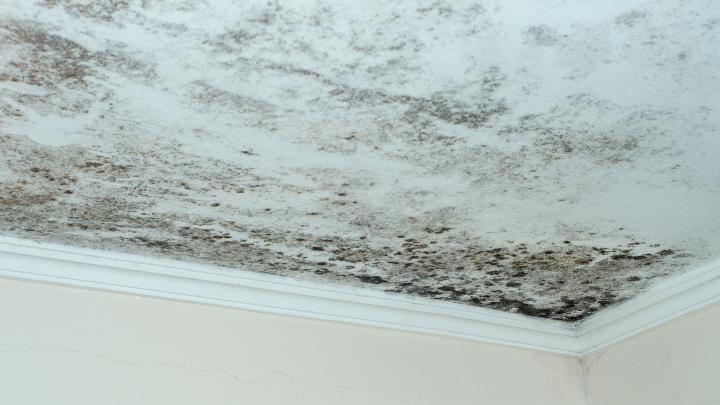The Ultimate Guide to Moisture Control and Mold Prevention
The article discusses the role of moisture control in preventing mold growth, highlighting the importance of maintaining optimal humidity levels and providing practical strategies for effective moisture control in buildings.

The Importance of Moisture Control in Mold Prevention
High humidity levels contribute to mold growth by creating an ideal environment for mold spores to thrive. When the humidity in a building is too high, it provides the perfect conditions for mold to flourish. This is because mold spores require moisture to germinate and grow, and high humidity levels provide the necessary moisture for the spores to thrive and spread. This is particularly concerning as mold can grow on a variety of organic materials commonly found in buildings, such as wood, drywall, and paper, potentially leading to structural damage if left unchecked.
Moreover, mold growth can pose significant health risks to occupants of the building. Exposure to mold can trigger allergic reactions, respiratory issues, and other health problems, particularly in individuals with pre-existing respiratory conditions or compromised immune systems. Therefore, effective moisture control is crucial for safeguarding the health and well-being of building occupants. In addition to health concerns, mold infestations can lead to structural damage to buildings, emphasizing the critical need for comprehensive moisture control measures.
Furthermore, guidelines from the EPA recommend fixing leaks and using exhaust fans as effective strategies for controlling indoor moisture levels. These preventive measures are essential for reducing the risk of mold growth and maintaining a healthy indoor environment. Proper moisture control in buildings not only mitigates the risk of mold infestations but also contributes to improving energy efficiency, reducing heating and cooling costs, and enhancing the overall comfort and safety of the indoor environment. By addressing moisture issues effectively, building owners can create a healthier and more sustainable indoor environment while also protecting their property from the damaging effects of mold growth.
 Understanding How High Humidity Contributes to Mold Growth
Understanding How High Humidity Contributes to Mold Growth
High humidity provides the perfect breeding ground for mold spores, contributing significantly to mold growth. When humidity levels are elevated, moisture accumulates on surfaces and in the air, creating conditions that are conducive to mold proliferation. This excess moisture can be attributed to various factors, including changes in building construction, which may lead to compromised structural integrity and increased susceptibility to moisture infiltration, ultimately fostering mold growth.
Furthermore, leaks within a building can introduce excess moisture, creating an environment that encourages mold development. Whether it's a leaky roof, plumbing issue, or poorly sealed windows, any form of water intrusion can elevate indoor humidity levels, promoting the colonization of mold spores. Inadequate ventilation exacerbates this problem by impeding the proper circulation of air, trapping excess moisture indoors and creating an environment ripe for mold propagation. These combined factors underscore the crucial role of effective moisture control measures in preventing mold growth and mitigating associated structural and health risks.
In addition, the maintenance of HVAC systems plays a pivotal role in mold prevention. When HVAC systems are not properly maintained, they can become a vehicle for the spread of mold spores throughout a building. Mold contamination within the HVAC system can lead to the dissemination of spores through the air, potentially affecting indoor air quality and contributing to widespread mold infestation. Therefore, ensuring the regular inspection, cleaning, and maintenance of HVAC systems is imperative in controlling mold proliferation and maintaining a healthy indoor environment.
This is a critical aspect of comprehensive mold prevention and underscores the importance of addressing high humidity through effective moisture control strategies to safeguard both the structural integrity of buildings and the well-being of occupants.
Effective Strategies for Moisture Control in Buildings
In addition to using dehumidifiers and air conditioners, there are several other effective strategies to control moisture and prevent mold growth in buildings. For instance, fixing leaks and using exhaust fans, as recommended by the EPA, are essential steps to maintain optimal indoor moisture levels. By promptly addressing leaks and utilizing exhaust fans, the risk of excess moisture accumulation and mold growth can be significantly reduced. These simple yet crucial measures are integral to maintaining a healthy indoor environment and preserving the structural integrity of buildings.
Furthermore, it's worth noting that the role of insulation and vapor diffusion retarders cannot be overstated when it comes to moisture control. Proper insulation helps regulate temperature and prevent condensation, which in turn reduces the potential for mold growth. Additionally, vapor diffusion retarders are effective in minimizing moisture transfer within building structures, further contributing to moisture control efforts. These strategies are particularly important in climates where moisture management is a prevalent concern, underlining the significance of tailoring approaches to address specific environmental conditions and construction types.
When considering moisture control in buildings, it's evident that a multifaceted approach is necessary to effectively mitigate the risk of mold growth. From utilizing dehumidifiers and air conditioners to implementing insulation and vapor diffusion retarders, each strategy plays a vital role in maintaining optimal indoor moisture levels and preventing the proliferation of mold. By understanding the unique requirements dictated by climate and construction, tailored approaches can be developed to address specific moisture issues and uphold the integrity of buildings. This comprehensive approach to moisture control is essential for creating safe, healthy, and mold-resistant indoor environments.
 The Significance of Dehumidification in Mold Prevention
The Significance of Dehumidification in Mold Prevention
Dehumidification plays a crucial role in preventing mold growth by effectively reducing indoor humidity levels, making it more challenging for mold spores to thrive and multiply. High humidity contributes to mold growth by providing the ideal environment for mold spores to settle and proliferate. When indoor humidity is reduced through dehumidification, the potential for mold growth is significantly minimized, thereby safeguarding buildings and occupants from the detrimental effects of mold infestation.
For instance, in regions with high humidity levels, such as coastal areas or tropical climates, dehumidifiers are indispensable in maintaining optimal indoor humidity levels. By removing excess moisture from the air, dehumidifiers help create an environment that is less conducive to mold growth, thus offering an effective strategy for mold prevention. Additionally, Mastertech Environmental employs advanced technologies and tools to ensure accurate mold testing results, providing clients with the confidence that their mold remediation and restoration services are backed by reliable and comprehensive assessment methods, ultimately contributing to effective moisture control and mold prevention.
Furthermore, prompt drying of buildings and furnishings after exposure to moisture is critical in preventing mold growth and structural damage. For example, after a water damage incident, thorough and rapid drying of affected areas is essential to mitigate the risk of mold infestation. Mastertech Environmental's expertise in prompt and efficient moisture control and drying techniques ensures that the potential for mold growth following water damage incidents is effectively minimized, offering clients peace of mind and protection against the long-term repercussions of mold-related issues.
In conclusion, dehumidification, coupled with efficient drying practices, stands as a cornerstone in the prevention of mold growth, highlighting its indispensable role in maintaining healthy indoor environments and preserving the structural integrity of buildings. For comprehensive mold removal and restoration services that prioritize effective dehumidification and moisture control, readers are encouraged to explore the advanced solutions offered by Mastertech Environmental for reliable and tailored approaches to mold prevention and remediation. Discover more about the comprehensive services and cutting-edge strategies provided by Mastertech Environmental by visiting their website at Mastertech Environmental for more details.
Practical Tips for Maintaining Optimal Humidity Levels
In addition to using dehumidifiers and air conditioners to reduce humidity levels, there are several other practical tips to consider for maintaining optimal humidity levels and preventing mold growth. When it comes to controlling moisture, prompt action is key. For instance, promptly fixing leaks in plumbing, roofs, or windows is crucial to prevent the accumulation of moisture, which can lead to mold growth. Furthermore, using exhaust fans in bathrooms, kitchens, and other areas prone to high humidity can effectively remove excess moisture from the air, thereby contributing to maintaining optimal humidity levels.
Another practical tip for maintaining optimal humidity levels is to be mindful of appliance use. Turning off appliances such as humidifiers, especially when moisture is present on glass interiors, is important for preventing the elevation of indoor humidity levels. This simple practice can significantly contribute to controlling moisture and reducing the risk of mold growth in indoor environments.
By implementing these practical tips, individuals can actively contribute to maintaining optimal humidity levels and effectively controlling moisture, ultimately reducing the risk of mold growth and its associated detrimental effects on buildings and indoor air quality. For comprehensive mold removal and restoration services, individuals can explore effective solutions at Mastertech Environmental.
Encouraging Proactive Measures for Moisture Control
Preventing mold growth through moisture control requires proactive measures to maintain optimal humidity levels. High humidity levels create an ideal environment for mold spores to thrive, leading to potential structural damage and health risks. To effectively prevent mold growth, it is essential to promptly fix leaks and use exhaust fans to control indoor moisture levels, as recommended by the EPA. Additionally, utilizing dehumidifiers and air conditioners can significantly reduce humidity levels, inhibiting the conditions necessary for mold growth.
One practical tip for maintaining optimal humidity levels is prompt action when moisture is present, such as using dehumidifiers and air conditioners, especially when moisture is detected on glass interiors. Furthermore, Mastertech Environmental offers certified mold inspections and indoor air quality assessments, including surface sampling and air quality testing for mold, black mold, and toxic mold, to assist in identifying and addressing potential mold issues. By taking proactive measures and leveraging the expertise of professionals, individuals can effectively control moisture and prevent mold growth.
Encouraging readers to explore effective solutions at Mastertech Environmental for comprehensive mold removal and restoration services can provide them with the necessary support and expertise in controlling moisture and preventing mold growth. By taking proactive steps and seeking professional assistance, individuals can create a healthier and mold-resistant environment in their homes and buildings.
If you or someone you know is interested in becoming a Mastertech Environmental Franchise Owner, click here for more information: https://www.mastertechfranchise.com/contact-us